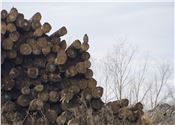Mississippi Adds Mill Capacity, Timber Moving

Since early 2021, Mississippi has gained several new timber mills, which has fostered optimism among the timber industry.
File photo by MSU Extension Service/Kevin Hudson
SUSAN M. COLLINS-SMITH
RAYMOND, MISSISSIPPI
Mississippi has gained new timber mills over the last 18months, and producers have seen timber prices rise since last year.
In 2021, the timber industry, which is one of the state’s top five most valuable agricultural commodities, ranked third with an estimated production value of nearly $1.29 billion.
“Other than pine pulpwood, prices for all major stumpage products are up from the first quarter of 2021,” said Shaun Tanger, forestry economics specialist with the Mississippi State University Extension Service.
Tanger said new sawmill construction and expansions by existing mills seems to be fostering optimism despite the caution around prices.
Enviva Biomass recently announced new mill construction in Bond, while Claw Forestry announced plans to build a new sawmill operation in Gloster.
“Anecdotally, several consultants have told me interest is up for timber properties in their respective regions,” he said. “Several of the new mills and expansions announced in 2020 are either going full speed or are close to being at full production. We expect to see all of them running at full production by the end of the year. So, from an added capacity standpoint things look very good for the long term.”
Other recently opened mills include Enviva’s wood pellet production facility in Lucedale, Idaho Forest Group’s Lumberton sawmill, Mission Forest Products’ Corinth mill and the Biewer Lumber mill in Winona.
These mills are a welcome addition to the nearly 70 timber production facilities Mississippi had in 2021.
“Overall, supply will continue to build, although more slowly, through 2028 to 2030,” he said. “Growth-to-drain ratios will improve dramatically, though. So, our forests will get healthier as the markets get healthier.”
Growth-to-drain ratio is a calculation used to compare timber growth to timber harvest yearly to help estimate how well supply is meeting demand. It can indicate whether timberland is a good long-term investment.
Tanger said more mills and conservative price increases indicate that the next five to seven years could bring more positive changes for landowners.
“The silver lining for landowners is that wood is moving and should continue to move with all the added mill capacity,” he said.
“Prices are up from last year. They are also up for loggers, but so too are costs. The logging workforce is really being pinched right now due in part to high fuel costs.”
Some wood mills are increasing the price they pay in some circumstances to help loggers with this issue. But mills may not continue to do this if fuel prices continue to rise, Tanger said.
The same may not be true for timber prices.
“I’m not sure prices are going to continue to rise for stumpage as the markets have seemed to pause in response to the recent interest rate hikes by the Federal Reserve Board,” Tanger said.
Overall, prices are higher this year compared to 2021. However, stumpage prices fell in the second quarter of 2022 compared to the first quarter, said Marc Measells, Extension forestry economist.
“There are several factors that contribute to the decrease, including the increased cost of logging and trucking operations because of higher diesel fuel prices, drier weather during the second quarter, declines in new home construction in 2022, and decreased lumber prices due to fewer homes being built,” Measells said. ∆
SUSAN M. COLLINS-SMITH: Mississippi State University